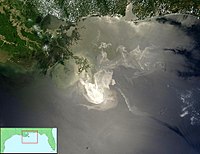
A new approach to testing potential leaching toxicity of fouling release coatings (FRCs).
Sign Up to like & getrecommendations! Published in 2018 at "Marine environmental research"
DOI: 10.1016/j.marenvres.2018.09.024
Abstract: Fouling release coatings (FRCs) are today the main environment-friendly alternative to traditional self-polishing coatings, that continuously release biocides and/or heavy metals into water. FRCs are available on the market as environmentally friendly AF paints and… read more here.
Keywords: coatings frcs; leaching products; fouling release; leaching ... See more keywords

Diffusion of surface-active amphiphiles in silicone-based fouling-release coatings
Sign Up to like & getrecommendations! Published in 2017 at "Progress in Organic Coatings"
DOI: 10.1016/j.porgcoat.2017.02.014
Abstract: Abstract Amphiphiles (i.e. amphiphilic molecules such as surfactants, block copolymers and similar compounds) are used in small amounts to modify the surface properties of polymeric materials. In silicone fouling-release coatings, PEG-based amphiphiles are added to… read more here.
Keywords: diffusion; biofouling resistance; surface; fouling release ... See more keywords

Field study of the long-term release of block copolymers from fouling-release coatings
Sign Up to like & getrecommendations! Published in 2017 at "Progress in Organic Coatings"
DOI: 10.1016/j.porgcoat.2017.07.001
Abstract: Abstract The addition of block copolymers (i.e. oils) is a common technique to enhance the biofouling-resistance properties of poly(dimethylsiloxane) (PDMS)-based fouling-release coatings. These copolymers diffuse from the bulk to the surface of the coating, thus… read more here.
Keywords: term; long term; fouling release; block copolymers ... See more keywords

The influence of MWCNTs-OH on the properties of the fouling release coatings based on polydimethylsiloxane with the incorporation of phenylmethylsilicone oil
Sign Up to like & getrecommendations! Published in 2019 at "Progress in Organic Coatings"
DOI: 10.1016/j.porgcoat.2019.01.055
Abstract: Abstract In order to control the leaching of phenylmethylsilicone oil (PSO) reasonably from the fouling release coating based on polydimethylsiloxane, the MWCNTs-OH/Fe2O3 composite coatings was investigated, including the surface properties, the mechanical properties, especially the… read more here.
Keywords: phenylmethylsilicone oil; based polydimethylsiloxane; fouling release; pso ... See more keywords

Sol-Gel-Based Hybrid Materials as Antifouling and Fouling-Release Coatings for Marine Applications.
Sign Up to like & getrecommendations! Published in 2020 at "ACS applied materials & interfaces"
DOI: 10.1021/acsami.0c15288
Abstract: Hybrid materials (HMs) offer unique properties as they combine inorganic and organic components into a single material. Here, we developed HM coatings for marine antifouling applications using sol-gel chemistry and naturally occurring polysaccharides. The coatings… read more here.
Keywords: hybrid materials; fouling release; coatings marine; antifouling fouling ... See more keywords

Studying the Effect of Pre-Polymer Composition and Incorporation of Surface-Modifying Amphiphilic Additives on the Fouling-Release Performance of Amphiphilic Siloxane-Polyurethane Coatings.
Sign Up to like & getrecommendations! Published in 2022 at "ACS applied materials & interfaces"
DOI: 10.1021/acsami.2c10983
Abstract: Combining amphiphilic fouling-release (FR) coatings with the surface-active nature of amphiphilic additives can improve the antifouling/fouling-release (AF/FR) properties needed to offer broad-spectrum resistance to marine biofoulants. This work is focused on further tuning the amphiphilic… read more here.
Keywords: surface; fouling release; siloxane polyurethane; amphiphilic siloxane ... See more keywords

Nitroxide-Containing Amphiphilic Random Terpolymers for Marine Antifouling and Fouling-Release Coatings.
Sign Up to like & getrecommendations! Published in 2023 at "ACS applied materials & interfaces"
DOI: 10.1021/acsami.2c23213
Abstract: Two types of amphiphilic random terpolymers, poly(ethylene glycol methyl ether methacrylate)-ran-poly(2,2,6,6-tetramethylpiperidinyloxy methacrylate)-ran-poly(polydimethyl siloxane methacrylate) (PEGMEMA-r-PTMA-r-PDMSMA), were synthesized and evaluated for antifouling (AF) and fouling-release (FR) properties using diverse marine fouling organisms. In the first stage… read more here.
Keywords: random terpolymers; antifouling fouling; amphiphilic random; fouling release ... See more keywords

Semifluorinated Synergistic Nonfouling/Fouling-Release Surface.
Sign Up to like & getrecommendations! Published in 2017 at "ACS applied materials & interfaces"
DOI: 10.1021/acsami.7b03258
Abstract: The preparation of a fluorine-containing synergistic nonfouling/fouling-release surface, using a b-PFMA-PEO asymmetric molecular brush possessing both poly(ethylene glycol) (PEO) and poly(2,2,2-trifluoroethyl methacrylate) (PFMA) side chains densely distributed on the same repeat unit along the polymeric… read more here.
Keywords: synergistic nonfouling; peo; surface; fouling release ... See more keywords

Surface modifying amphiphilic additives and their effect on the fouling-release performance of siloxane-polyurethane coatings
Sign Up to like & getrecommendations! Published in 2021 at "Biofouling"
DOI: 10.1080/08927014.2021.1901891
Abstract: Abstract In this work, surface-modifying amphiphilic additives (SMAAs) were synthesized via hydrosilylation using various polymethylhydrosiloxanes (PMHS) and allyl-terminated polyethylene glycol monomethyl ethers (APEG) of varying molecular weights. The additives synthesized were incorporated into a hydrophobic,… read more here.
Keywords: amphiphilic additives; surface modifying; modifying amphiphilic; fouling release ... See more keywords

Grooming of fouling-release coatings to control marine fouling and determining how grooming affects the surface
Sign Up to like & getrecommendations! Published in 2022 at "Biofouling"
DOI: 10.1080/08927014.2022.2084389
Abstract: Abstract Grooming may be an effective technique to control marine biofouling without damaging the coating or discharging active ingredients into the environment. This study assessed the grooming performance of three experimental biocide-free siloxane polyurethane (SiPU)… read more here.
Keywords: grooming; control marine; fouling release; release coatings ... See more keywords

Fouling Release Coatings Based on Acrylate–MQ Silicone Copolymers Incorporated with Non-Reactive Phenylmethylsilicone Oil
Sign Up to like & getrecommendations! Published in 2021 at "Polymers"
DOI: 10.3390/polym13183156
Abstract: Copolymers containing MQ silicone and acrylate were synthesized by controlling the additive amount of compositions. Subsequently, fouling release coatings based on the copolymer with the incorporation of non-reactive phenylmethylsilicone oil were prepared. The surface properties… read more here.
Keywords: silicone; phenylmethylsilicone oil; fouling release; release coatings ... See more keywords